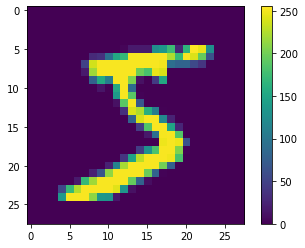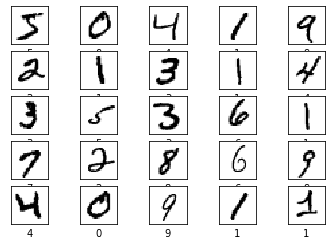In today’s lesson we will explore how different parameters like weight initialization, dropout, regularization, and others can affect training and testing accuracy. We will be working with the same numbers data set
1) Packages
Let’s first import all of the packages we need for this assignment.
-
tensorflow is what we will use to build our neural networks
-
matplotlib helps to plot data and visualize the data
-
numpy helps us make our training and test set arrays
-
keras helps us to make our neural networks
#Author: Leila Abdelrahman
#Adapted from the Classify Images of Clothing Website by François Chollet, 2017, MIT
#Import TensorFlow and Keras
import tensorflow as tf
from tensorflow import keras
#Helper libraries
import numpy as np
import matplotlib.pyplot as plt
2) Import the MNIST dataset
mnist = keras.datasets.mnist
(train_images, train_labels), (test_images, test_labels) = mnist.load_data()
#Loading the dataset should return 4 NumPy arrays
#Next, add class name labels, as these are not included with the datast. Stoer them in an
#array for later as we plot the images
class_names = ['0', '1', '2' , '3', '4', '5', '6', '7', '8',
'9']
3) Look at dataset parameter
#Look at the parameters of the dataset
#The data set contains 60,000 images in the training set, each represented as 28*28 poxels
print(train_images.shape)
(60000, 28, 28)
#There are 60,000 traning labels
len(train_labels)
60000
#Each label has an integer between 0 and 9;
print(train_labels)
[5 0 4 ... 5 6 8]
#Thee are 10,000 images in the test set, each 28*28 pixels
print(test_images.shape)
(10000, 28, 28)
4) Data before normalization
#Preprocess the data so that we can normalize the pixel values between a range of 0 and 1.
#Normalization helps with training accuracy
plt.figure()
plt.imshow(train_images[0])
plt.colorbar()
plt.grid(False)
plt.show()

5) Normalize the data
#We now want to scale the values. Do this by dividing by 255, hwhich is the largest pixel value
train_images = train_images/255.0
test_images = test_images/255.0
6) Look at new normalized pictures
#Verify that the data is in the correct format and that it is standardized
for i in range (25):
plt.rcParams.update({'font.size': 10})
plt.subplot(5,5,i+1)
plt.xticks([])
plt.yticks([])
plt.grid(False)
plt.imshow(train_images[i], cmap = plt.cm.binary)
plt.xlabel(class_names[train_labels[i]])
plt.show()

7) Build the original model.
Every neural network is composed of layers. Each layer represents extracting representations from the data fed into them.
- This neural network has 3 layers.
- The first layer (Flatten), transforms the image data from a 2d array to a 1d array
- The second layer is a Dense function (a densly connected neural layer, which as 128 nodes, or neurons)
- The last layer has 10 nodes, and uses the softmax activation function.
Softmax activation functions return probability scores tht sum to 1. MAKE SURE THE NUMBER OF NODES IN THE LAST LAYER IS EQUAL TO THE NUMBER OF CLASSES.
model = keras.Sequential([
keras.layers.Flatten(input_shape = (28,28)) ,
keras.layers.Dense(128, activation = 'relu'),
keras.layers.Dense(10, activation = 'softmax')
])
Let’s look at the anatomy of the model. This outlines what each layer is, and how many parameters (arguments) there are.
print(model.summary())
Model: "sequential"
_________________________________________________________________
Layer (type) Output Shape Param #
=================================================================
flatten (Flatten) (None, 784) 0
_________________________________________________________________
dense (Dense) (None, 128) 100480
_________________________________________________________________
dense_1 (Dense) (None, 10) 1290
=================================================================
Total params: 101,770
Trainable params: 101,770
Non-trainable params: 0
_________________________________________________________________
None
8) Now it’s your turn!
You can try Xavier, Random, All Zeroes, etc.
# Define model2 as including weight initialization
model2 = keras.Sequential([
keras.layers.Flatten(input_shape = (28,28)) ,
keras.layers.Dense(128, activation = 'relu' , kernel_initializer = "glorot_normal"),
keras.layers.Dense(10, activation = 'softmax' , kernel_initializer = "glorot_normal")
])
9) Build a model with Dropout.
Now, add dropout to your model2 and call it model3. Make sure to play around with the dropout rate to see how that affects accuracy.
#Define model3 with dropout
model3 = keras.Sequential([
keras.layers.Flatten(input_shape = (28,28)) ,
keras.layers.Dense(128, activation = 'relu' , kernel_initializer = "glorot_normal"),
keras.layers.Dropout(0.5),
keras.layers.Dense(10, activation = 'softmax' , kernel_initializer = "glorot_normal")
])
10) Complile the models with optimizer, loss, and metrics
- Loss function: steers the model in the right direction. Loss is calculated by how accurate the model is at classifying
- Optimizer: the model uses an optimization funcition to minizmize the loss function
- Metrics: Records accuracy of how well the model correctly classifies the images
Change the loss function and the optimizer function to see how that may affect accuracy
# Here is an example for the orginal model
model.compile(optimizer = 'adam' ,
loss = 'sparse_categorical_crossentropy',
metrics = ['accuracy'])
#Add code here to compile and add different loss and optimizers for the new model2 and model3
#Model2:
model2.compile(optimizer = 'nadam' ,
loss = 'sparse_categorical_crossentropy',
metrics = ['accuracy'])
#Model3:
model3.compile(optimizer = 'adagrad' ,
loss = 'sparse_categorical_crossentropy',
metrics = ['accuracy'])
11) Train the models
- Step 1: feed the training data to the model. In this case it is the train_images and train_labels arrays
- Step 2: Model learns over a series of epochs. Each epoch represents one “step” in the learning process
- Step 3" Ask the model to make predictions about the test set.
#Original model
model.fit(train_images, train_labels, epochs = 10)
Train on 60000 samples
Epoch 1/10
60000/60000 [==============================] - 4s 67us/sample - loss: 0.2622 - accuracy: 0.9259
Epoch 2/10
60000/60000 [==============================] - 3s 58us/sample - loss: 0.1143 - accuracy: 0.9661
Epoch 3/10
60000/60000 [==============================] - 3s 58us/sample - loss: 0.0788 - accuracy: 0.9767
Epoch 4/10
60000/60000 [==============================] - 3s 58us/sample - loss: 0.0593 - accuracy: 0.9817
Epoch 5/10
60000/60000 [==============================] - 3s 58us/sample - loss: 0.0447 - accuracy: 0.9865
Epoch 6/10
60000/60000 [==============================] - 3s 58us/sample - loss: 0.0357 - accuracy: 0.9891
Epoch 7/10
60000/60000 [==============================] - 3s 58us/sample - loss: 0.0288 - accuracy: 0.9912
Epoch 8/10
60000/60000 [==============================] - 3s 57us/sample - loss: 0.0232 - accuracy: 0.9930
Epoch 9/10
60000/60000 [==============================] - 3s 57us/sample - loss: 0.0197 - accuracy: 0.9939
Epoch 10/10
60000/60000 [==============================] - 3s 58us/sample - loss: 0.0154 - accuracy: 0.9954
Train on 60000 samples
Epoch 1/10
60000/60000 [==============================] - 4s 73us/sample - loss: 0.2610 - accuracy: 0.9262
Epoch 2/10
60000/60000 [==============================] - 4s 65us/sample - loss: 0.1136 - accuracy: 0.9662
Epoch 3/10
60000/60000 [==============================] - 4s 64us/sample - loss: 0.0782 - accuracy: 0.9761
Epoch 4/10
60000/60000 [==============================] - 4s 65us/sample - loss: 0.0579 - accuracy: 0.9822
Epoch 5/10
60000/60000 [==============================] - 4s 65us/sample - loss: 0.0457 - accuracy: 0.9854
Epoch 6/10
60000/60000 [==============================] - 4s 64us/sample - loss: 0.0361 - accuracy: 0.9886
Epoch 7/10
60000/60000 [==============================] - 4s 65us/sample - loss: 0.0281 - accuracy: 0.9915
Epoch 8/10
60000/60000 [==============================] - 4s 65us/sample - loss: 0.0235 - accuracy: 0.9927
Epoch 9/10
60000/60000 [==============================] - 4s 65us/sample - loss: 0.0197 - accuracy: 0.9942
Epoch 10/10
60000/60000 [==============================] - 4s 65us/sample - loss: 0.0171 - accuracy: 0.9946
Train on 60000 samples
Epoch 1/10
60000/60000 [==============================] - 4s 71us/sample - loss: 0.9713 - accuracy: 0.7254
Epoch 2/10
60000/60000 [==============================] - 4s 64us/sample - loss: 0.6450 - accuracy: 0.8146
Epoch 3/10
60000/60000 [==============================] - 4s 64us/sample - loss: 0.5728 - accuracy: 0.8335
Epoch 4/10
60000/60000 [==============================] - 4s 64us/sample - loss: 0.5313 - accuracy: 0.8462
Epoch 5/10
60000/60000 [==============================] - 4s 65us/sample - loss: 0.5043 - accuracy: 0.8541
Epoch 6/10
60000/60000 [==============================] - 4s 65us/sample - loss: 0.4845 - accuracy: 0.8601
Epoch 7/10
60000/60000 [==============================] - 4s 65us/sample - loss: 0.4701 - accuracy: 0.8661
Epoch 8/10
60000/60000 [==============================] - 4s 65us/sample - loss: 0.4567 - accuracy: 0.8684
Epoch 9/10
60000/60000 [==============================] - 4s 65us/sample - loss: 0.4433 - accuracy: 0.8719
Epoch 10/10
60000/60000 [==============================] - 4s 65us/sample - loss: 0.4378 - accuracy: 0.8740
<tensorflow.python.keras.callbacks.History at 0x25d79f72188>
#Add code here for model2:
model2.fit(train_images, train_labels, epochs = 10)
Train on 60000 samples
Epoch 1/10
60000/60000 [==============================] - 4s 66us/sample - loss: 0.0136 - accuracy: 0.9961
Epoch 2/10
60000/60000 [==============================] - 4s 66us/sample - loss: 0.0119 - accuracy: 0.9961
Epoch 3/10
60000/60000 [==============================] - 4s 66us/sample - loss: 0.0104 - accuracy: 0.9968
Epoch 4/10
60000/60000 [==============================] - 4s 66us/sample - loss: 0.0095 - accuracy: 0.9973
Epoch 5/10
60000/60000 [==============================] - 4s 66us/sample - loss: 0.0092 - accuracy: 0.9970
Epoch 6/10
60000/60000 [==============================] - 4s 66us/sample - loss: 0.0067 - accuracy: 0.9980
Epoch 7/10
60000/60000 [==============================] - 4s 66us/sample - loss: 0.0067 - accuracy: 0.9979
Epoch 8/10
60000/60000 [==============================] - 4s 65us/sample - loss: 0.0057 - accuracy: 0.9981
Epoch 9/10
60000/60000 [==============================] - 4s 66us/sample - loss: 0.0064 - accuracy: 0.9982
Epoch 10/10
60000/60000 [==============================] - 4s 66us/sample - loss: 0.0059 - accuracy: 0.9980
<tensorflow.python.keras.callbacks.History at 0x25d7a3ccec8>
#Add code here for model3:
model3.fit(train_images, train_labels, epochs = 10)
Train on 60000 samples
Epoch 1/10
60000/60000 [==============================] - 4s 65us/sample - loss: 0.4255 - accuracy: 0.8780
Epoch 2/10
60000/60000 [==============================] - 4s 66us/sample - loss: 0.4206 - accuracy: 0.8788
Epoch 3/10
60000/60000 [==============================] - 4s 66us/sample - loss: 0.4145 - accuracy: 0.8826s - loss: 0.4143 - accuracy: 0.
Epoch 4/10
60000/60000 [==============================] - 4s 66us/sample - loss: 0.4100 - accuracy: 0.8814
Epoch 5/10
60000/60000 [==============================] - 4s 66us/sample - loss: 0.3995 - accuracy: 0.8853
Epoch 6/10
60000/60000 [==============================] - 4s 66us/sample - loss: 0.3965 - accuracy: 0.8876
Epoch 7/10
60000/60000 [==============================] - 4s 66us/sample - loss: 0.3920 - accuracy: 0.8872
Epoch 8/10
60000/60000 [==============================] - 4s 65us/sample - loss: 0.3885 - accuracy: 0.8884
Epoch 9/10
60000/60000 [==============================] - 4s 65us/sample - loss: 0.3825 - accuracy: 0.8904
Epoch 10/10
60000/60000 [==============================] - 4s 65us/sample - loss: 0.3769 - accuracy: 0.8914s - loss: 0.3768 - accuracy: 0.
<tensorflow.python.keras.callbacks.History at 0x25d7a4338c8>
12) Test the models
You will notice that the test accuracy is less than the training accuracy. Look at how overfitting compares after adding weight initialization and dropout
#model1:
test_loss, test_acc = model.evaluate(test_images, test_labels, verbose = 2)
print('\n Model 1 Test accuracy:', test_acc)
#model2: Add code here:
test_loss, test_acc = model2.evaluate(test_images, test_labels, verbose = 2)
print('\n Model 2 Test accuracy:', test_acc)
#model3: Add Code here:
test_loss, test_acc = model2.evaluate(test_images, test_labels, verbose = 2)
print('\n Model 3 Test accuracy:', test_acc)
10000/1 - 0s - loss: 0.0443 - accuracy: 0.9752
Model 1 Test accuracy: 0.9752
10000/1 - 0s - loss: 0.0501 - accuracy: 0.9793
Model 2 Test accuracy: 0.9793
10000/1 - 0s - loss: 0.0501 - accuracy: 0.9793
Model 3 Test accuracy: 0.9793